There's Money in Garbage: A Collage for LMAC #144
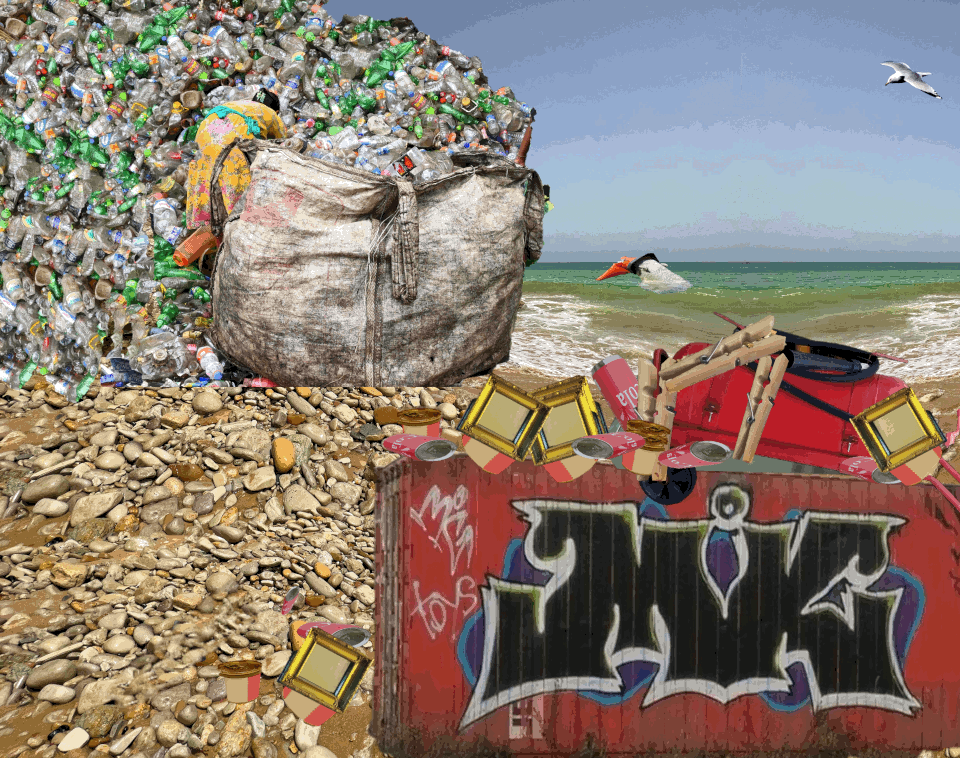
The beautiful picture offered by @shaka in this week's LMAC collage contest deserves a more attractive rendering than what I offer here. However, this is what came to mind. Maybe it's because I'm cleaning out my house: forty-eight years of accumulated possessions. We're giving away what we can, but so much of it is trash. Where does that all go? Someone, somewhere will have to deal with it. In a way, we all have to deal with it, eventually.
Template Photo by @shaka
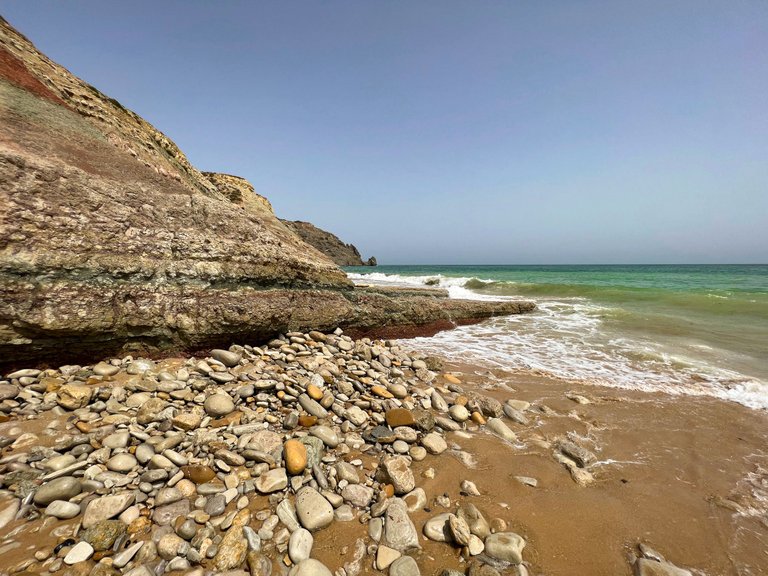
Garbage Dump Communities
There is a picture in my collage of a woman collecting trash. The picture from which this is derived showed children in the dump. I couldn't bring myself to include them in the collage. It bothers me to show that picture here.
An article in International Samaritan reported that in 2017, an estimated 15 million people lived and worked in garbage dumps around the world. In 2019, the Borgan Project reported that in many parts of the world, non government agencies are in charge of waste disposal in unregulated dumps. "These companies employ a large percentage of children under the age of 18."
What is the difference between a garbage dump and a landfill?
According to Dumpster.com Blog, "A landfill is a government-regulated place where waste is treated, monitored and properly layered. A dump is most often an illegal site where people take their trash that is unregulated and poses a risk to the environment".
Waste Generation Per Day Per Capita
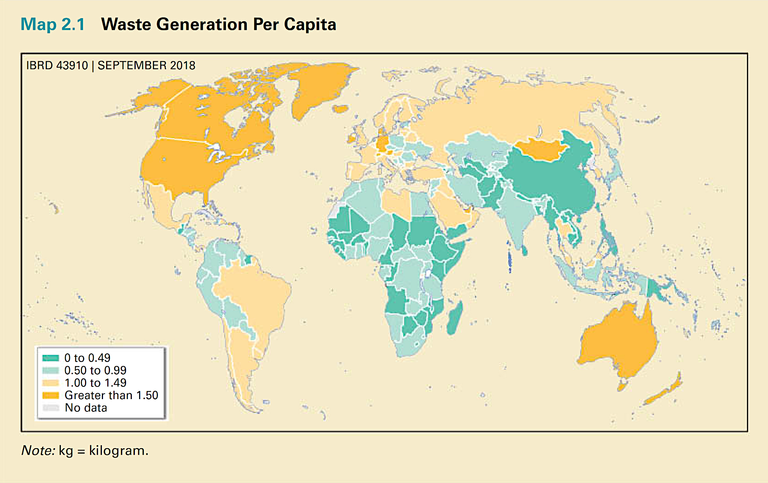
Credit: Kaza, Silpa; Yao, Lisa C.; Bhada-Tata, Perinaz; Van Woerden, Frank. Used under CC 3.0 license
Landfills are more likely to be found in developed countries, and dumps in less developed countries. Up until 2018, China received a lot of the trash, particularly plastic trash, the rest of the world didn't want. In 2018 China enacted the "National Sword" policy and thus closed its doors to most of that refuse. Since then, much of the world's exported plastic waste has been redirected to countries not equipped to handle it. These countries include Bangladesh, Laos, Ethiopia, and Senegal, (info from The Guardian) and India, Malaysia and Indonesia (info from rePurpose).
Projected (2025) Mismanaged Plastic Waste, by Region
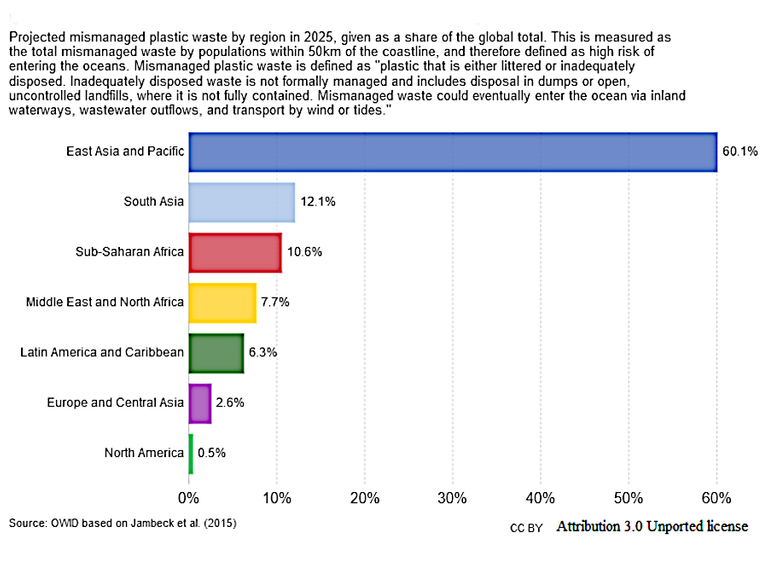
Credit: Our World In Data. Used under 3.0 Unported License
According to the Borgen Project the countries to which the waste has been redirected, "...have since become overwhelmed... greatly amplifying the plight of the children" who live and work in the trash heaps.
Most consumers have become conscientious about 'recycling': disposed plastics are placed in designated recycled bins. What happens to it after that? According to the Plastic Pollution Coalition, "Most plastic items collected as recycling are not actually recycled. ...plastic is not designed to be recycled." Our disposed plastic becomes part of the global waste industry. "$500 billion...is generated annually in the global waste market".
Residential garbage trucks dumping a load in Savage, Minnesota, USA.
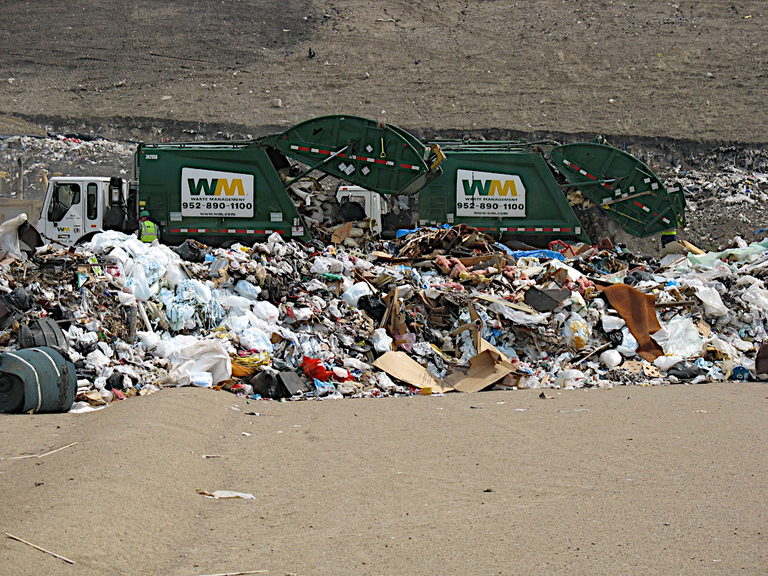
Credit: Redwin Law. Used under CC 2.0 license
Even before the plastic reaches its destination, whether that is domestic or abroad, it begins to pollute the environment. Plastic escapes. It gets blown away. Falls off a vehicle. Gets carried away by gulls and is absorbed into the environment.
Throwing Stuff Away
I grew up in a time when we used to throw stuff away. There was garbage, we put it out and someone took it away. Then there was a period when we all thought we could recycle, and that would take care of our refuse. However there is no 'away'. If we don't want to be stuck with plastic pollution in our air, our oceans and even our bodies, then we simply have to stop using the stuff.
That is the only sure path to making plastic go 'away'.
I want to thank my friends who contributed to the LIL Gallery. I couldn't have made the collage without them.
@muelli contributed the grafitti trailer.
@redheadpei contributed the gull.
@quantumg contributed the soda cans.
@mynatash contributed random items in the garbage
I borrowed also from Pixabay: the Bear with a plastic cone on its head, from Wildfaces, and from Mumtahina01 the remarkable picture of the children gathering garbage.
Here are a few steps I took in making the collage:
1.Broaden the frame; add garbage pile and bear.
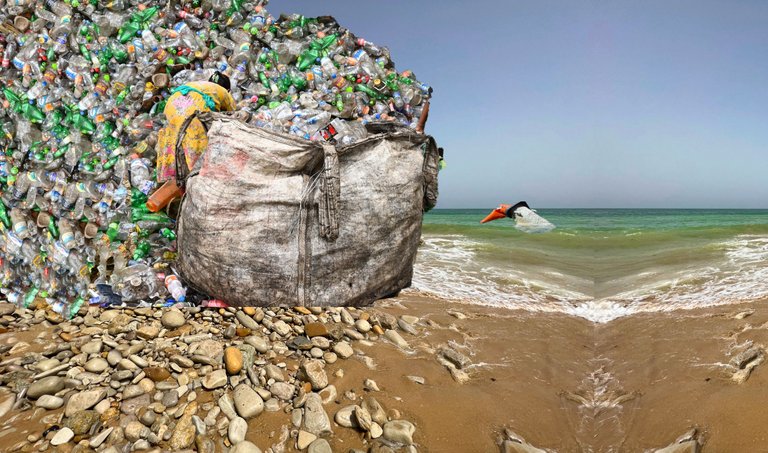
2.Add @muelli's trailer
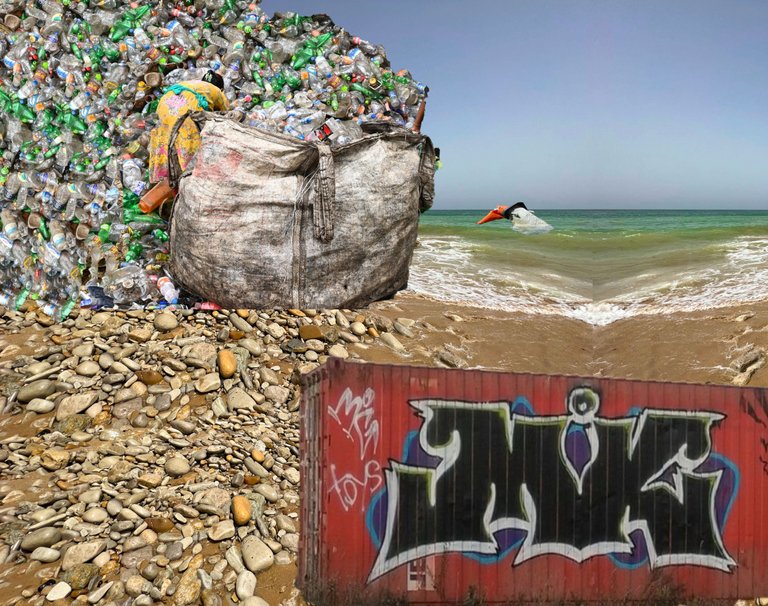
3.Add @mynatasha's trash, @quantumg's cans, @redheadpei's gull and a can I had contributed to LIL some time ago.
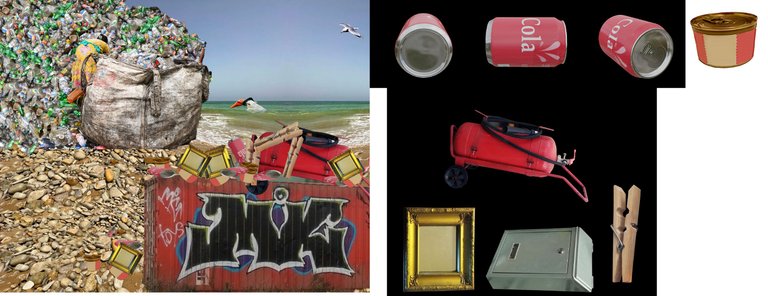
4.Make the frames (many tries) that show the bird, the bear, woman's head, and the soda can moving (synchronized).
Here is my first try, where only the bird and the trash move:
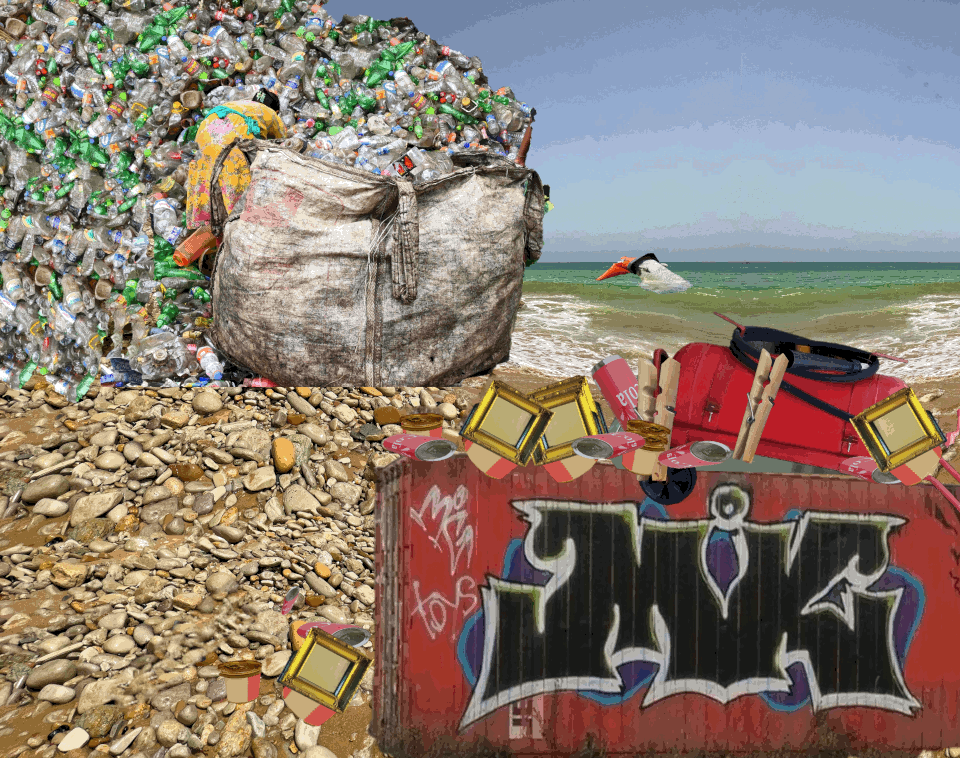
Can you see I enjoyed myself in making this, as unpleasant as the subject was? I recommend the exercise. The 144th round has concluded now, all but the voting. Please join us in picking winners for this week. Prizes are significant. You can vote here. Our new round, #145, starts Thursday. Check out @shaka's blog for procedures. (I do not compete because I am on the jury.)
Also, please check out our Gallery, LIL. Anyone on Hive may borrow from LIL (all public domain images), and anyone may contribute images to the gallery. Procedures explained here.
Thank you for reading my blog. I wish all of my readers peace, and health.
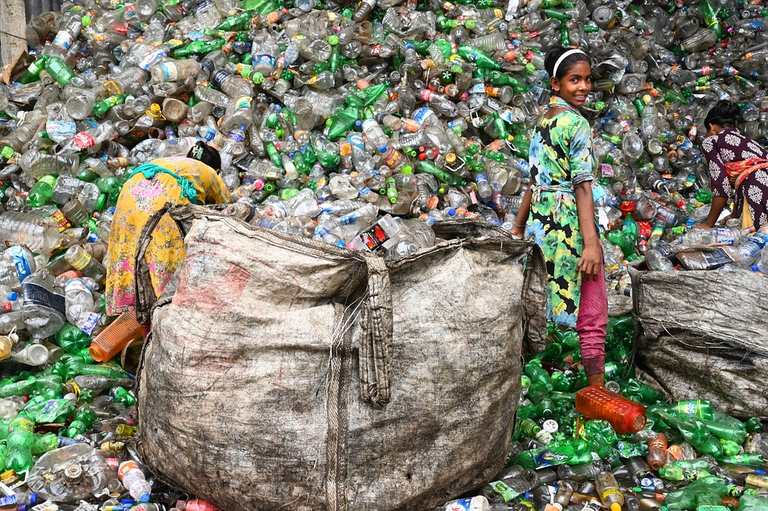
https://twitter.com/416626589/status/1582414456080175104
The rewards earned on this comment will go directly to the people( @agmoore ) sharing the post on Twitter as long as they are registered with @poshtoken. Sign up at https://hiveposh.com.
Excelente @agmoore, más que un collage es un excelente reporte. De verdad que es una situación lamentable que ningún país está libre de ello. Y es más penoso aun que se empleen niños para realizar labores dentro de un vertedero de basura.
Breaks your heart, doesn't it? Hard to look at the picture with smiling children surrounded by trash.
Thank you for your comment, @cesarisaad
Very good information that you share with your collage, I think it is something that no country is saved from and there is more and more garbage in the world. Hopefully technology will create something to reduce it on a large scale.
Greetings my dear! 🤗
Hello @mballesteros, my friend. Very nice to see you here. Even if a country thinks it is safe, there is no hiding from pollution. It affects all of us. Technology, and our behavior, will have to change this.
Hope you are well and peaceful. Thanks for the comment.
Hi @agmoore.
What a wonderful animation, brilliantly done. I love the way this bird flies and then catches the clip away. Its fly is so smooth and realistic! O_O Really well done.
And it's not just a (edu-)collage, it's a powerful message too. Thumbs up!
Greetings! :-)
PS: Thanks for using my can from the LIL.
I'm very happy when you like my collages. There is nothing beautiful about this, but it does speak, doesn't it?
Your can is perfect. When I made the garbage bin I had your can(s) in mind--I remembered it. Your LIL contributions are all so useful.
Thanks for stopping by @quantumg.
I like the implementation of the theme very much. It's really well done. Of course, I like less what it says. As someone who travels a lot in nature, environmental protection is very close to my heart and I am often stunned how careless some of my fellow men are.
Here in Switzerland, however, it is basically very clean and garbage is separated and usually disposed of properly.
It cannot be denied that the so-called "first world" produces the most waste. This is mainly due to our consumption. But on my travels I have noticed that despite the large amount of waste produced, we still have a relatively good way of dealing with it. In Africa, for example, everything, really everything, just lies on the street or in the bush. It seems that a society with less prosperity also cares much less about its environment. Actually, this is logical and it means that one form of environmental protection would be to make sure that the wealth in the world as a whole is better distributed.
Another thing is to avoid unnecessary packaging, etc. This is something that consumers can actively influence through their purchasing decisions.
Thanks for your collage, it brings attention to an important issue!
Hello @captainloken, I checked. Switzerland handles waste responsibly🙂:
That is reassuring.
Thank you for visiting. I'm glad you like my collage, although it is an unattractive piece. As a story teller, and history buff, I tend to go toward literal collages. I am not an artist. But that's what's great about LMAC. There is room for everyone who makes a sincere effort.
Thanks for sending me down the research path that taught me more about EU waste management regulations.
Nice to see you place well in the final round of the contest this week :) Congratulations!
Thank you, its allways an honor for me to make it in to the final poll.
Your posts are always so timely and this one deals with a problem that even the world leaders are having a struggle trying to find a solution….if there is one, as you mentioned, besides stop using plastics and other articles harmful to the environment.
Wonderful colorful depiction of garbage, A. G. Thanks for including the gull from the lil gallery. He fits right in. Love how he flies around,😊
Are you moving? Since you are cleaning out your house I thought perhaps you were moving.
Hello my friend, @redheadpei,
I love your gull. It soars beautifully, doesn't it? As I went about my activities yesterday and today I was more sensitive to the trash I was generating. Writing the blog was a good exercise.
We are thinking of moving. Nothing is certain, but change is inevitable. How we adjust our living arrangements is up in the air, but it is obvious that we have to make some kind of change. It is that time in life when inevitable change looms even if we don't acknowledge it.
I hope late autumn treats you well. Weather here has been tolerable and I am grateful. Keeping my fingers crossed (toes too😆)
Thanks for stopping by.
Most welcome A.G. We have been having lovely sunny days since the hurricane but nights are cool. I hope it lasts awhile as winter is not that far away. 🥶
We have quite a recycling program here on the Island. A place for everything. Compost and waste bins to be taken to roadside and collected on alternate weeks. Blue bags for recyclables picked up once a month. Labels to be removed from all cans. Bottles and containers to be clean before putting in blue bag. Certain bottles can be returned to a recycling station for a deposit.
I hope you find a suitable accommodation. You will not like leaving your strays unless someone else will look after them.
Have a great rest of the week A.G. and keep well. 💕
Your trash disposal system sounds wonderful😊
You know me well. I have seen what happens when others leave, or die, and the strays are left. In this case, we only have two left. One just died. They are quite old. My neighbor helps to care for them now. I'm sure she wouldn't mind moving igloos a couple of feet over to her property (there is not even a fence between us) so the remaining cat/cats will have a home. In the past (when we had many more cats) my neighbor let us use the electrical outlet in her backyard to plug in heating pads for the igloos. We ran out of outlets 😄One of the cats wants to come indoors, so there is always the possibility that it will be domesticated. Whatever way we choose, the cats will be provided for.
It is so like you to think of them 🌺🌸
Have a wonderful week, and be well my friend @redheadpei
It’s great to have wonderful neighbors. You can move without worrying about the remaining cats. 😸
I have only one cat (Red) left now. There hasn’t been any stray cats coming around lately… only the raccoon and skunk along with the squirrel and chipmunk. 😊
An insightful collage as always @agmoore,the rate in which plastic is being swished off is alarming. The seas, gutters, roads, etc. Pollution is trashy😕
Thank you @seki1. I figure, if I'm going to use space on this platform, I might as well say something. I think @muelli is my inspiration for that. If you look at some of his past collages, he has a great sense of humor (quite dark, often), but he always says something.
I appreciate your comment very much.
Aaah then I guess I'll go check his blog then.😂
This collage presents a scenario of environmental pollution, so I see it as a reminder of how humans can change the natural landscape. It's a good way of alerting us.
On the other hand, the collage is great, it has a very nice animation work.
Thank you for commenting, @innfauno12. When I alert others, I alert myself. Whenever I make a collage or write a blog, I try to learn as I go along. I think that makes the piece more interesting.
I appreciate your kind estimation of my collage :)